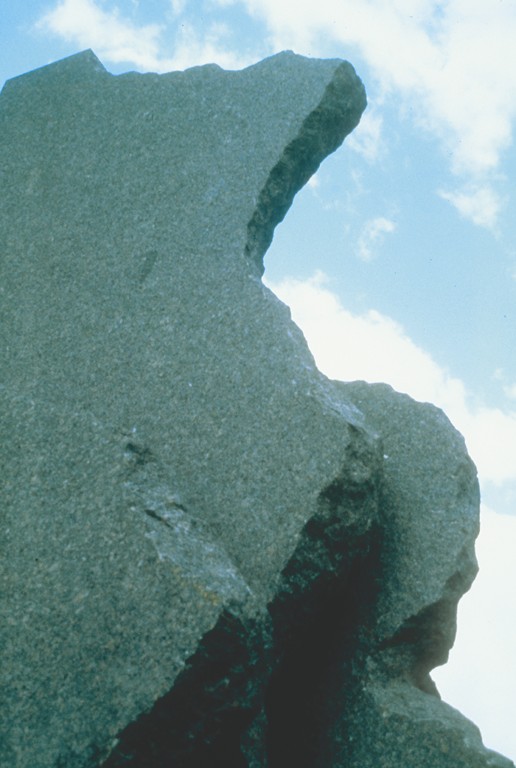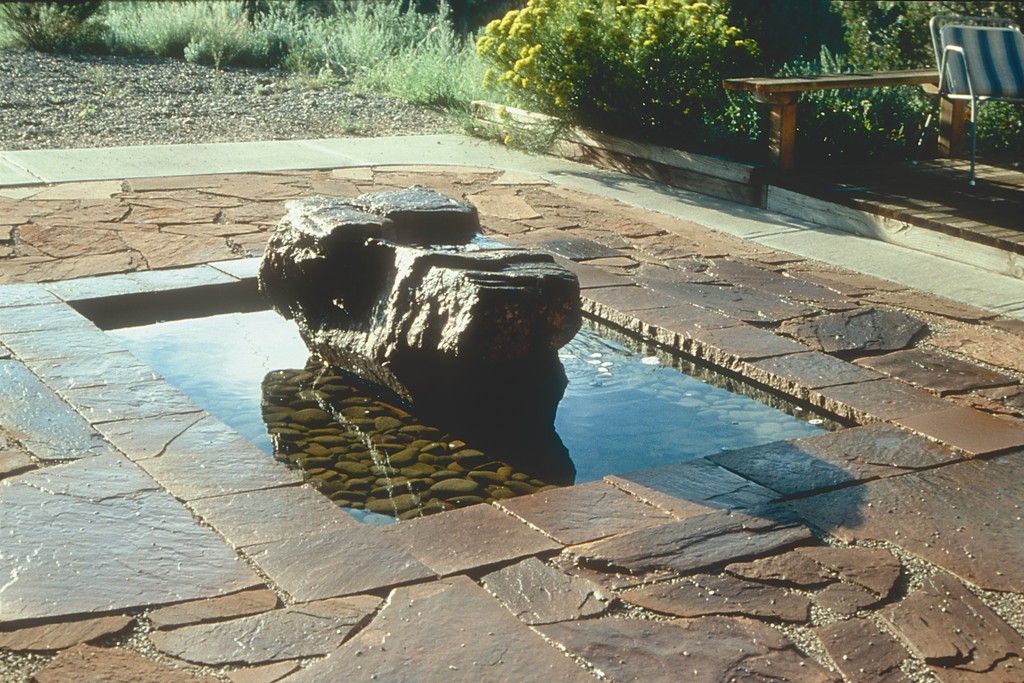Poetry in Stone

The avant-garde composer John Cage once said, “Art exists to make us aware of the very life we’re living.” I’ve always loved that statement because, as someone working to create works of art, the experiences of my own life have naturally been transferred into the way I’ve chosen to express myself – and, I hope, have enabled me to succeed in bringing other people to an awareness of experiences in their own lives.
For me, water is the key in these transferences: Even though I’m probably more often described as a sculptor of natural stone rather than as a watershaper, the dialogues I have with the materials I use and with those who observe the outcomes have always begun with the way I work with water.
I grew up in the Midwest on the banks of the Mississippi. As a child, I lingered on the untamed shores of the creeks, streams and rivers that laced across an otherwise developed and thoroughly mechanized landscape.
I would read or draw, stroll idly along a stream, or spend hours building a raft or dam. This was well before I’d begun to think about my relationship with water in any sort of artistic way, but there’s no question that those experiences remain at the heart of my passion for working within this endlessly complex and intriguing medium.
DIALOGUES WITH NATURE
When I went off to college at William & Mary in Williamsburg, Va., I initially studied poetry. But the first time I wandered into a ceramics studio, my love affair with sculpture began. Working at first in clay, I quickly discovered that I was the most interested when the material assumed a rough, stony texture.
One day, I thought, “Yes, of course: stone.” Soon thereafter, I recognized that my artistic impulses were best expressed in sublime combinations of water and stone – and I’ve been exploring their collaborative poetry ever since.
These days, I live and work in an adobe studio tucked in the Colorado Rockies just a few miles from the banks of the upper Arkansas River. In these spectacular surroundings, I’m engaged daily by the complex, native “conversations” between stone and water and see local settings as a constant source of profound inspiration.
In cultivating this inspiration, I’ve come to appreciate Colorado’s big picture – the broad landscapes, massive landforms and breathtaking views. But I’m even more drawn to the smallest of patterns and details, such as the fine grain in stone or the odd place on a stone edge where a small runnel of water has flowed to create a subtle and unique tracery.
As I approach the Arkansas River, I seek out intimate details that exist within the larger context. Often, these observations have to do with the interaction of water and stone, but they’re also about water and soil or even water and ice and snow. I was recently hiking on the banks, for instance, when I noticed the way that the sweep of the main current in one stretch had carved an incredibly graceful arc in a bank of ice along the shore.
Even though I do relatively large-scale sculptural pieces, I’m always looking for ways to add details that draw viewers closer and closer to my work. As I conceptualize a piece at the commission stage, for example, I might envision someone walking toward it and encountering a vigorous cascade of water, throbbing with energy as it dances downward. But as that person approaches, I want his or her attention to be rewarded with smaller, deft revelations of texture, sound and the interplay of light and shadow.
These intimacies are so important that I would characterize my design process as one of starting with an up-close vantage point, considering the intimate experiences first, then stepping away to encompass the larger context and the broader landscape. I design this way because I always hope that someone who starts by reading and interpreting my work from afar will be inspired to come closer.
TERMS OF DISCUSSION
As artisan and sculptor, I owe much to traditional stonemasons who’ve given modern sculptors a wonderful set of tools and skills we can use in interpreting stone. I’ve made a point of studying those traditional and, in some cases, ancient mason’s techniques, and I enjoy the way that using such tools and methods links my efforts with centuries-old traditions and practices.
At the same time, I have tremendous respect for the hydro-technology and techniques used by modern watershapers. The way that water can be sprayed and propelled into the air is all fascinating and exciting stuff.
Within my own work, however, I tend to use these hydraulic technologies and techniques to create understated, naturalistic flows that evoke subtle feelings and memories among their viewers. Sometimes, of course, I’ll run 300 gallons per minute down a narrow slot with all sorts of exuberance, but in others and more often, I’ll fill a basin so slowly that the water barely climbs over the edge.
Either way, what I want to do is let the water express itself in some specific way.
To that extent, my work is inspired by Japanese garden design, wherein water is brought into close view and allowed to create its own dialogue with the viewer through its interactions with simple natural elements of stone, wood and earth. The masters of Japanese design understand that through their artful interventions, they can, in a sense, liberate the water to express its native character and thus encourage observers to interpret the forms that water surrounds, covers, fills and caresses.
In sharp contrast, however, I’m also inspired by water in utilitarian forms. In the American Midwest, for example, you might come upon a well that fills an old concrete basin, or a windmill that draws water into a stock tank, or a retention pond used for irrigation. In such settings, the water offers stark and refreshing beauty in the midst of an otherwise arid landscape.
So whether it’s through nature, art or in the service of humankind, water provides constant variety and richness – but without having shape, color or form on its own. Therein rests one of the natural world’s most delicious ironies – and a big part of why I see and appreciate stone as the perfect foil to water’s ephemeral nature and physical qualities.
QUIET INTERVENTIONS
At heart, I see a piece of stone as the “form memory” of a specific geological process. It offers detailed evidence of the immense pressure, heat, thrust, erosion and/or sedimentation that were required to shape it. And the fact that we’re aware of this and able to see these processes in the stone itself enables me to use that information for art’s sake – to my way of thinking, a profound privilege.
In limestone, for example, we see and can touch layers of sediment laid down in prehistoric seas. In granite, which is my primary working material, we see igneous rock forged by inconceivable heat and pressure and ultimately brought to light by heaving up-thrusts that somehow brought it to the surface.
The stones I use in my sculptural projects are gathered from abandoned quarries, derelict gravel pits or the reject piles of large fabrication operations – never from native rock formations. This concept of “aesthetic recycling” was inspired by George Nakashima, a woodworker who collected unusual, cast-off boards from around the world and turned them into beautiful furniture.
As I get down to business, I’ll look at a stone and contemplate its forms, then I consider where I might split it to emphasize a particular contour and express the character I see within the stone. In fact, I’ve found the best way to highlight the beauty of a contour is to give it a crisp plane that has clearly been placed by the artist’s hand. Or I might carve into that plane or consider ways to create a sense of line and space by juxtaposing a selected stone with other stones.
With those basic decisions made, the techniques I use are quite simple: I drill into the stone, set masons’ feathers and wedges and hammer away. It’s a fascinating process that is mostly a matter of sound: As I drive the wedges in with my hammer, I listen for changes and await the unique tearing sound that heralds a split. It’s hard work, but there’s a drama and excitement to it that sometimes makes me laugh out loud when the rock gives way.
And when the stone opens, it always reveals something that hasn’t ever been seen by human eyes before. It becomes something new by way of my artistic impulse, a process I’ve applied for the purpose of finding character and form within what nature has provided.
Once water is brought together with the stone, its character is both articulated and amplified: Colors are enriched, figures are accentuated and the opportunity for the interplay of light, sound and motion all become part of the conversation.
Richard Hansen is a sculptor and associate professor of art at the University of Southern Colorado in Pueblo. He earned a bachelor’s degree in fine arts at the College of William & Mary in 1971 and his masters in landscape architecture from the University of Colorado in 1985. He has served as a visiting artist and lecturer at the Rhode Island School of Design, the University of Illinois, the University of Minnesota, Colorado State University, Iowa State University, Kansas State University, the University of Kansas, and the Illinois Institute of Technology’s Italy Program. Hansen has designed and installed projects throughout the United States. His public output has been the subject of a variety of exhibitions and retrospectives, and he has traveled extensively throughout Europe and Asia studying and teaching art history.























